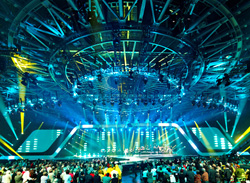The market in LED based lighting fixtures has possibly seen the biggest growth area in the stage lighting industry in recent years. All of the major stage lighting manufacturer have dived into the LED market while cheap imported lights mean that every church, small band or DJ can get a slice of the action too.
Rental companies are now expected to stock a wide range of LED units alongside their tungsten conventionals and discharge moving lights and the technology is developing rapidly. If you are new to using LED lighting or are thinking of adding LED to your inventory, we present a guide to LED stage lighting.
What’s so exciting about LEDs?
LED (Light Emitting Diode) technology has now developed to become a usable source of light in live performance and recorded media. LED fixtures have some advantages over ‘old’ tungsten based instruments and are particularly attractive to the events and concerts market right now. Manufacturers specializing in theatre and television equipment are also developing more sophisticated LED based fixtures to answer the needs of those shows too.
Let’s have a look at what lighting folks like about LEDs.
● Low Power Consumption – Because LEDs draw a comparatively small amount of power, you can use a lot of fixtures on smaller supply such as a wall socket. This is great for small band lighting rigs and the disco/party DJ. Bearing in mind that 20 years ago we were still working with large rigs of PAR cans, there are also benefits of low(er) power requirements for the large show too.
● Low Heat – Although LED stage lighting does produce heat, fixtures produce light without getting extremely hot as with their tungsten or discharge counterparts. In some environments, the lower heat properties of LED stage lighting are very desirable.
● Lightweight and Portable – The hardware that LED fixtures are packaged in does not need to be heavy and even with the various power supplies and other elements, LED units are usually fairly lightweight. To make them even more portable, LED units can be more readily powered by battery and several products boast battery power and wireless control via DMX over WiFi. This creates a lighting product that you can place and control quickly with no messy wires and a minimum of fuss.
● Color Effects – A common use of LED for stage lighting purposes is additively mixing a combination of different colored LEDs. A fixture with all three lighting primary colors, Red, Green and Blue (RGB) LEDs blended together in different combinations gives the lighting designer easy access to many color choices in one fixture. More complex LED color mixing fixtures use additional sources such as RGBA (Amber), RGBW (White) or more such as with the ETC Selador 7 color range of LEDs. The color functionality of all these fixtures does away with creating color subtractively using gel filters completely.
● Small and Compact – LED lighting fixtures can be made in small, discreet packages which suit applications where size and appearance are important such as exhibitions stands.















